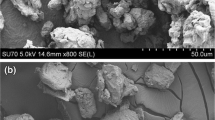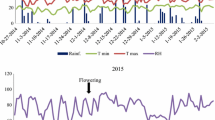Abstract
The seeds of three promising advanced lines of soybeans (TGx 923-2EN, TGx 1019-2EN and TGx 1497-1D) which were part of a larger collection evaluated in agronomic field trials in Nigeria were selected for characterization of physicochemical properties, chemical composition, water absorption, cooking time and cooked texture as a function of soaking and cooking. Seed density, leached solids, swelling capacity and seed coat percentage were within a range of 1.15 to 1.26 g per ml, 1.00 to 1.26 g per 100 g, 80.25 to 84.35 g per 100 g and 6.6 to 10.1% w/w of dry beans, respectively. The total polyphenol content of the cream colored beans was similar (0.75 to 0.76 mg/g) but higher than the amount (0.60 mg/g) found in the white beans. Cooking times varied between 71 and 96 min without soaking and were reduced by about 32.0% following a presoaking treatment in water for 12 hours at room temperature (28±1°C). Small seeds absorbed higher amounts of water during soaking and required less cooking time than larger seeds. Unsoaked beans required 40 min of cooking to achieve the same degree of cooked texture as the soaked beans cooked for 20 min, suggesting that cooking times and cooked texture for all lines were improved through soaking.
Similar content being viewed by others
References
Akinrele IA, Edwards CCA (1971) An assessment of the nutritive value of a maize-soya mixture, ‘Soy-Ogi’, as a weaning food in Nigeria. Br J Nutr 26: 177–185.
Igbedioh SO (1991) Use, problems and prospects of soybean in infant weaning practices in Africa. Nutr Health 7: 177–188.
Dashiell KE, Bello LL, Root WW. (1984) Breeding soybeans for the tropics. In: Singh SR, Rachie KO, Dashiell KE (eds), Soybeans for the tropics. Chichester: John Wiley and Sons, pp 3–16.
Mwandemele OD, McWhirter KS (1984) Improving the quality of soybean (Glycine max L. Merril) for human consumption: Factors influencing the cookability of soybean seeds. J Food Sci Technol 21: 286–290.
Walker AF, Kochhar N (1982) Effect of processing including domestic cooking on nutritional quality of legumes. Proc Nutr Soc 41: 41–51.
Wang HL, Swain EW, Hesseltine CW, Health HD (1979) Hydration of whole soybeans affects solids losses and cooking quality. J Food Sci 44: 1510–1513.
Longe OG (1983) Varietal differences in chemical characteristics related to cooking quality of cowpea. J Food Proc Preserv 7: 143–150.
Hincks MJ, Stanley DW (1986) Multiple mechanisms of bean hardening. J Food Technol 21: 731–750.
Stanley DW, Aguilera JM (1985) A review of textural defects in cooked reconstituted legumes: The influence of structure and composition. J Food Biochem 9: 277–323.
Hsu KH, Kim CJ, Wilson LA (1983) Factors affecting water uptake of soybeans during soaking. Cereal Chem 60: 208–211.
Deshpande SS, Sathe SK, Salunkhe DK (1984) Interrelationships between certain physical and chemical properties of dry bean (Phaseolus vulgaris). Plant Foods Hum Nutr 34: 53–65.
Akinyele IO, Onigbinde AC, Hussain MA, Omololu A (1986) Physicochemical characteristics of 18 cultivars of Nigerian cowpeas (Vigna unguiculata) and their cooking properties. J Food Sci 51: 1483–1485.
Giami SY, Okwechime UI (1993) Physicochemical properties and cooking quality of four new cultivars of Nigerian cowpea (Vigna unguiculata L. Walp.). J Sci Food Agric 63: 281–286.
Molina MR, Baten MA, Gomez-Brenes RA, King RW, Bressani R (1976) Heat treatment: A process to control the development of the hard-to-cook phenomenon in black beans (Phaseolus vulgaris). J Food Sci 41: 661–666.
Phirke AV, Chavan JK, Jadhar SJ, Salunkhe DK (1982) Physical properties, chemical composition, cookability and solubilization of proteins of dry beans (Phaseolus vulgaris L.). Legume Res 5: 91–96.
AOAC (1984) Official methods of analysis, 14th edn. Washington, DC: Association of Official Analytical Chemists.
Singh U, Subrahmanyam N, Kumar J (1991) Cooking quality and nutritional attributes of some newly developed cultivars of chickpea (Cicer arietinum). J Sci Food Agric 55: 37–46
Demooy BE, Demooy CJ (1990) Evaluation of cooking time and quality of seven diverse cowpea (Vigna unguiculata. L. Walp.) varieties. Int J Food Sci Technol 25: 209–212.
Giami SY (1991) Effects of pretreatments on the texture and ascorbic acid content of frozen plantain pulp (Musa paradisiaca). J Sci Food Agric 55: 661–666.
Wilson MF, Blunden CA (1983) Changes in the levels of polyphenols in three pear varieties during bud development. J Sci Food Agric 34: 973–978.
Steel RG, Torrie JH (1960) Principles and procedures of statistics. New York: McGraw-Hill.
Hafez YS (1983) Nutrient composition of different varieties and strains of soybean. Nutr Rep Int 28: 1197–1206.
Ologhobo AD (1986) Composition and food potentials of dry and germinated legume seeds and their sprouts. Nig Food J 4: 34–44.
Ene-Obong HN, Carnovale E (1992) A comparison of the proximate, mineral and amino acid composition of some known and lesser known legumes in Nigeria. Food Chem 43: 169–175.
Onayemi O, Osibogun OA, Obembi O (1986) Effect of different storage and cooking methods on some biochemical, nutritional and sensory characteristics of cowpea (Vigna unguiculata L. Walp.). J Food Sci 51: 153–156, 160.
King RD, Ashton SJ (1985) Effect of seed coat thickness and blanching on the water absorption by soybeans. J Food Technol 20: 505–509.
El-Saled HM, Abdel-Hamid AE (1981) Cooking quality of broad bean varieties as influenced by some physicochemical measurements. Agric Research Centre (Giza, Egypt) 20: 200–207.
Jackson GM, Varriano-Marston E (1981) Hard-to-cook phenomenon in beans, 1: Effects of accelerated storage on water absorption and cooking time. J Food Sci 46: 799–803.
Varriano-Marston E, Jackson GM (1982) Hard-to-cook phenomenon in beans: structural changes during storage and imbibition. J Food Sci 46: 1379–1385.
Author information
Authors and Affiliations
Rights and permissions
About this article
Cite this article
Giami, S.Y. Evaluation of selected food characteristics of three advanced lines of Nigerian soybean (Glycine max (L.) Merr.). Plant Food Hum Nutr 50, 17–25 (1997). https://doi.org/10.1007/BF02436039
Received:
Accepted:
Issue Date:
DOI: https://doi.org/10.1007/BF02436039




